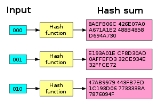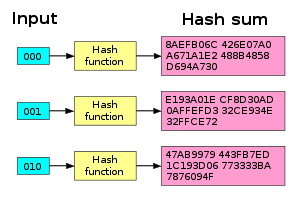
Avalanche effect
Encyclopedia
In cryptography
, the avalanche effect refers to a desirable property of cryptographic algorithm
s, typically block cipher
s and cryptographic hash function
s. The avalanche effect is evident if, when an input is changed slightly (for example, flipping a single bit) the output changes significantly (e.g., half the output bits flip). In the case of quality block ciphers, such a small change in either the key
or the plaintext
should cause a drastic change in the ciphertext
. The actual term was first used by Horst Feistel
, although the concept dates back to at least Shannon's diffusion.
 If a block cipher or cryptographic hash function does not exhibit the avalanche effect to a significant degree, then it has poor randomization, and thus a cryptanalyst can make predictions about the input, being given only the output. This may be sufficient to partially or completely break the algorithm. Thus, the avalanche effect is a desirable condition from the point of view of the designer of the cryptographic algorithm or device.
If a block cipher or cryptographic hash function does not exhibit the avalanche effect to a significant degree, then it has poor randomization, and thus a cryptanalyst can make predictions about the input, being given only the output. This may be sufficient to partially or completely break the algorithm. Thus, the avalanche effect is a desirable condition from the point of view of the designer of the cryptographic algorithm or device.
Constructing a cipher or hash to exhibit a substantial avalanche effect is one of the primary design objectives. This is why most block ciphers are product cipher
s. It is also why hash functions have large data blocks. Both of these features allow small changes to propagate rapidly through iterations of the algorithm, such that every bit
of the output should depend on every bit of the input before the algorithm terminates.
and avalanche and was introduced by Webster and Tavares in 1985.
Cryptography
Cryptography is the practice and study of techniques for secure communication in the presence of third parties...
, the avalanche effect refers to a desirable property of cryptographic algorithm
Algorithm
In mathematics and computer science, an algorithm is an effective method expressed as a finite list of well-defined instructions for calculating a function. Algorithms are used for calculation, data processing, and automated reasoning...
s, typically block cipher
Block cipher
In cryptography, a block cipher is a symmetric key cipher operating on fixed-length groups of bits, called blocks, with an unvarying transformation. A block cipher encryption algorithm might take a 128-bit block of plaintext as input, and output a corresponding 128-bit block of ciphertext...
s and cryptographic hash function
Cryptographic hash function
A cryptographic hash function is a deterministic procedure that takes an arbitrary block of data and returns a fixed-size bit string, the hash value, such that an accidental or intentional change to the data will change the hash value...
s. The avalanche effect is evident if, when an input is changed slightly (for example, flipping a single bit) the output changes significantly (e.g., half the output bits flip). In the case of quality block ciphers, such a small change in either the key
Key (cryptography)
In cryptography, a key is a piece of information that determines the functional output of a cryptographic algorithm or cipher. Without a key, the algorithm would produce no useful result. In encryption, a key specifies the particular transformation of plaintext into ciphertext, or vice versa...
or the plaintext
Plaintext
In cryptography, plaintext is information a sender wishes to transmit to a receiver. Cleartext is often used as a synonym. Before the computer era, plaintext most commonly meant message text in the language of the communicating parties....
should cause a drastic change in the ciphertext
Ciphertext
In cryptography, ciphertext is the result of encryption performed on plaintext using an algorithm, called a cipher. Ciphertext is also known as encrypted or encoded information because it contains a form of the original plaintext that is unreadable by a human or computer without the proper cipher...
. The actual term was first used by Horst Feistel
Horst Feistel
Horst Feistel was a German-born cryptographer who worked on the design of ciphers at IBM, initiating research that would culminate in the development of the Data Encryption Standard in the 1970s....
, although the concept dates back to at least Shannon's diffusion.

Constructing a cipher or hash to exhibit a substantial avalanche effect is one of the primary design objectives. This is why most block ciphers are product cipher
Product cipher
In cryptography, a product cipher combines two or more transformations in a manner intending that the resulting cipher is more secure than the individual components to make it resistant to cryptanalysis. The product cipher combines a sequence of simple transformations such as substitution,...
s. It is also why hash functions have large data blocks. Both of these features allow small changes to propagate rapidly through iterations of the algorithm, such that every bit
Bit
A bit is the basic unit of information in computing and telecommunications; it is the amount of information stored by a digital device or other physical system that exists in one of two possible distinct states...
of the output should depend on every bit of the input before the algorithm terminates.
Strict avalanche criterion
The strict avalanche criterion (SAC) is a generalization of the avalanche effect. It is satisfied if, whenever a single input bit is complemented, each of the output bits changes with a 50% probability. The SAC builds on the concepts of completenessCompleteness (cryptography)
In cryptography, a boolean function is said to be complete if the value of each output bit depends on all input bits.This is a desirable property to have in an encryption cipher, so that if one bit of the input is changed, every bit of the output has an average of 50% probability of changing...
and avalanche and was introduced by Webster and Tavares in 1985.

